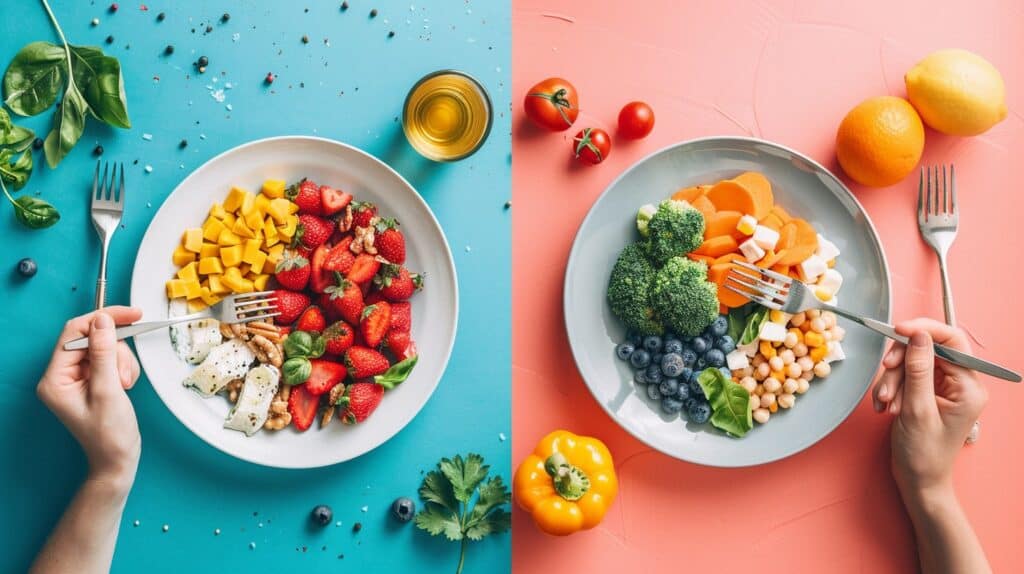Are you tired of the diet yo-yo and ready for something real? Fact: Elyse Resch and Evelyn Tribole kick-started a food revolution in the 90s with Intuitive Eating. This post will arm you with insights into Mindful Eating and Intuitive Eating – helping you decide which might better suit your journey to a healthier, happier you.
Let’s dig in…
Key Takeaways
Mindful eating focuses on the experience of eating, paying attention to flavors, textures, and feelings without distraction. It helps reduce binge and emotional eating while supporting weight management and diabetes control.
Intuitive Eating encourages you to listen to your body’s hunger signals over external diet rules. Created by Elyse Resch and Evelyn Tribole in the 90s, it boosts self-esteem and reduces disorders related to body image by promoting a healthy attitude towards food.
Both mindful and intuitive eating aim at improving your relationship with food. They stress enjoying meals without guilt, listening to your body’s needs, rejecting diet culture, but they approach it differently—mindful is about how we eat; intuitive focuses on why we eat.
Implementing these practices involves simple steps like starting small with one mindful meal a day, or keeping a food diary for emotions rather than calories. Ditching the diet mindset and making peace with all foods are key strategies.
Additional health strategies include lifestyle modifications such as staying hydrated, getting enough sleep, reducing processed foods’ intake, managing stress effectively, exercising regularly, making dietary adjustments for better nutrition balance, exploring medical options if needed like gastric balloons for weight loss support or utilizing technology tools that track health habits to enhance wellness journey effectiveness.
Table of Contents
Definition of Mindful Eating

Mindful eating? It’s like putting your brain in the driver’s seat when you’re at the dinner table. You savor each bite, noticing all the flavors, textures, and even the thoughts that pop up as you chew.
Principles of Mindful Eating
Eating isn’t just about chowing down. It’s an art, a journey through flavors and sensations. Mindful eating turns every bite into a vibrant symphony of taste and texture. Let’s break it down, fellas.
- Savor the flavor – Next time you eat, slow it down. Really taste your food. That burger isn’t just “good”; it’s a burst of smoky, savory joy with each bite.
- Listen to your body – Hunger cues are like subtle nudges saying, “Hey, I need fuel!” Fullness cues are the polite way of saying, “Enough, pal.” Tune in and listen closely.
- Chew thoroughly – Don’t wolf down your food like there’s no tomorrow. Chew each mouthful well to break down your food and savor those flavors.
- Ditch distractions – Turn off the TV, put away your phone. It’s just you and your meal now. This isn’t the time for multitasking; give your grub the attention it deserves.
- Know your hunger – Before you reach for that snack, ask yourself: Am I really hungry? Sometimes thirst masquerades as hunger…or boredom does.
- Breathe between bites – Take a breath or two between forkfuls. It’s not a race to the finish line; let digestion do its thing without overloading the system.
- Appreciate where food comes from – Think about the journey from farm to plate. Those veggies didn’t just appear; they grew from soil, watered by rain under the sun’s watchful eye.
- Notice how foods make you feel – Some foods uplift you; others bring you down faster than a lead balloon after a party’s over… Remember which is which.
- Embrace all sensations – Food isn’t just taste; it’s texture, color, smell…a feast for all senses! Enjoy that crispy crunch or silky smoothness.
- Let go of guilt – Ate too much cake? Overindulged in chips? It happens to the best of us… Don’t beat yourself up—a new start begins with your next meal.
There you have it! Master these principles and transform mealtime into an enriching experience that nourishes not only your body but also your soul and mind—because mindful eating is less about losing weight or following diet rules and more about making every bite count towards better health and happiness.
Benefits of Mindful Eating
Mindful eating turns every bite into a mini-vacation. Imagine savoring the crunch of an apple, feeling its juice burst with flavor—this is mindful eating. It’s not just about enjoying food more; it’s a game changer for health.
This approach can tamp down on binge and emotional eating. You start to see food as your ally, not an enemy lurking in the pantry.
And let’s talk waistlines and blood sugar — mindful eating has your back here too. Studies show it aids in losing weight and managing type 2 diabetes better than any fad diet that makes you cut out carbs like they’re bad news.
Definition of Intuitive Eating

Intuitive eating is like trusting your gut when it comes to food. It’s about eating what feels right for your body, no rules or restrictions.
Core Principles of Intuitive Eating
Intuitive Eating is all about kicking diet culture to the curb and listening to your body. Developed by Elyse Resch and Evelyn Tribole in the 1990s, it’s a game changer for those fed up with diets.
- Reject the diet mentality – Throw out those diet books and magazine articles that promise quick weight loss. They’re not your friends.
- Honor your hunger – Keep your body biologically fed with enough calories and carbohydrates. It keeps the hunger monster at bay.
- Make peace with food – Give yourself unconditional permission to eat. Viewing food as a friend rather than an enemy flips the script on eating.
- Challenge the food police – Scream a loud “No” to thoughts in your head that declare you’re “good” for eating minimal calories or “bad” because you ate a piece of chocolate cake.
- Discover the satisfaction factor – Find pleasure and satisfaction in eating by embracing what feels good and what tastes good.
- Feel your fullness – Listen for the body signals that tell you that you are no longer hungry. Pause in the middle of eating and ask yourself how the food tastes, and what is your current fullness level.
- Cope with your emotions without using food – Anxiety, loneliness, boredom, anger—food won’t fix any of these feelings. It may comfort for the short term, but it won’t solve the problem.
- Respect your body – Accept your genetic blueprint. Not everyone is meant to be a certain size or shape; respect what you’ve got.
- Exercise—feel the difference – Forget about burning calories; focus on how good it feels to move your body instead.
- Honor your health—gentle nutrition – Choose foods that honor your health and taste buds while making you feel good.
Switching gears now, let’s see how Mindful Eating plays into this conversation…
Benefits of Intuitive Eating
Eating intuitively cranks up self-esteem and cuts back on eating disorders and body image woes. Think of it as hitting the gym but for your mind’s attitude towards food. You’ll find yourself stepping off the scale, ditching the guilt after scarfing down a burger, and embracing what your body genuinely needs.
It’s not just about feeling good in your skin; studies suggest folks who eat this way might even sport a lower body mass index (BMI).
Imagine chowing down without tallying every calorie or stressing over “bad” foods. That steak? Go ahead—your body’s got the cues to guide you right. And when cravings hit, instead of wrestling with them, you’ll learn to understand what they really mean.
Whether it’s reaching for that salty snack because you’re bored or genuinely hungry, intuitive eating turns each meal into a lesson in self-care and awareness—all without needing to count a single calorie.
Comparing Mindful and Intuitive Eating

Now, let’s lay it on the line between mindful and intuitive eating. Think of it as choosing between listening to a hit song or the full album – both have their vibes, but which one really gets you grooving?.
Focus and Philosophy
Mindful eating and intuitive eating might seem like two sides of the same coin, yet they sit at different tables. Mindful eating draws its roots from Buddhist traditions, emphasizing being present with your food, savoring every bite, and acknowledging how it makes you feel physically and emotionally.
Think Jon Kabat-Zinn meets dinner—this practice is all about engaging the senses, understanding the journey of your food from plate to palate, and recognizing its impact on your mood and well-being.
On the flip side, intuitive eating throws diet books out the window. Developed by dietitians Elyse Resch and Evelyn Tribole in the ’90s, this approach encourages listening to your body’s hunger cues rather than clock-watching for meal times.
It’s a call to break up with calorie counting and welcome a more holistic relationship with food—one that celebrates nourishment over punishment. So while mindful eating asks you to pay attention to how you eat, intuitive eating focuses on why you eat… and says it’s okay to reach for that piece of chocolate if that’s what your body truly desires.
Awareness vs Cues
Mindful eating and Intuitive Eating both bring attention to how we eat, but they tap into different signals. Mindful eating has us focusing on the present moment, really tasting each bite, feeling textures, and noticing colors on our plate.
It’s like turning a regular meal into a sensory experience—a way to enjoy every flavor fully without rushing through your food. On the other hand, Intuitive Eating encourages us to listen closely to our bodies’ cues—hunger pangs tell us it’s time to eat; satisfaction says we’ve had enough.
This approach helps ditch the guilt around food by trusting our internal systems over external diet rules.
Both methods aim to repair our relationship with food, making meals more about nourishment and pleasure rather than stress or guilt. By tuning in closely—whether it’s savoring each bite or recognizing hunger and fullness—we start making choices that feel good for our bodies and minds.
Ready for an even deeper dive? Let’s explore how these two approaches can work together…
Similarities and Differences
Jumping from the concepts of awareness versus cues, we land in the world where Mindful Eating and Intuitive Eating share a meal. Both philosophies invite you to enjoy food without feeling guilty.
They say “no” to diet culture and give a big thumbs up to listening to your body. This means eating when you’re hungry and stopping when you’re full—sounds simple, right? Plus, they both aim for peace with food; think less stress about what’s on your plate and more enjoyment of each bite.
Here’s where things fork off a bit, though. Mindful eating is like having a spotlight on your current meal; it’s all about savoring flavors, textures, and even the sound of crunching.
It pushes for being 100% present with every nibble. On the flip side, Intuitive Eating steps back and looks at the bigger picture: rejecting diets that don’t work long-term and learning to trust your gut—literally—to guide what you eat based on hunger and satisfaction signals rather than rigid rules or schedules.
So while one has its lens zoomed in, focusing on the here-and-now experience of eating, the other pans out to capture how we interact with food in our lives at large—both roads leading towards healthier attitudes toward feeding ourselves.
The Interplay of Mindful and Intuitive Eating

Mindful eating tells us to slow down and savor every bite, turning meals into a meditation. Think about it like listening closely to your favorite song, noticing every note and rhythm.
Now apply that same attention to your food, feeling the textures, tasting the flavors, and appreciating the colors on your plate. It’s all about being present in the moment. This mindfulness can help you recognize when you’re truly hungry or just bored.
On the flip side, intuitive eating kicks diet rules out of the window and urges you to listen to your body’s hunger signals instead. Say goodbye to counting calories or measuring portions.
If mindful eating is about how we eat, intuitive eating focuses on why we eat… and why sometimes we shouldn’t—even if that apple pie is calling our name from across the room! Together, these practices help steer clear of mindless munching during Monday night football games or stress-eating after a tough day at work.
They teach us self-compassion while navigating our complex relationship with food—no guilt trips allowed here!
Tips for Implementing Mindful and Intuitive Eating

So, we’ve talked about how Mindful and Intuitive Eating work together. Now, let’s dive into some practical tips to make these concepts a part of your life.
- Start small. You don’t have to overhaul your entire eating habit overnight. Try focusing on one meal a day where you really pay attention to your hunger cues and savor each bite.
- Keep a food diary—but not for calories. Instead of tracking every calorie, jot down what you eat, how it makes you feel, and any emotions tied to eating. Over time, patterns will emerge that can help guide healthier food choices.
- Listen to your body—it’s smarter than you think! If you’re hungry, eat. If you’re full, stop. Sounds simple, but breaking the cycle of eating because the clock says so takes practice.
- Ditch the diet mentality. Throw out those rigid rules about what and when you should eat. This tip might be tough for men over 40 who’ve spent a lifetime following different diets.
- Make peace with food. Yes, even with those foods labeled as “bad.” Remember that all foods can fit into a healthy diet in moderation.
- Get curious about flavors and textures—like, really curious! Whether it’s the crunchiness of an apple or the spiciness of a chili pepper, focusing on these details can turn eating into a more engaging experience.
- Delete distractions at meal times. Turn off the TV, put away your phone, and just concentrate on your meal and how it makes you feel both physically and emotionally.
- Practice patience with yourself because change doesn’t happen overnight… Or after one meal… Or even after ten meals! It’s okay if it feels weird or challenging at first; keep going!
- Find supportive pals or social media groups who are also on this journey towards healthier eating habits without judgment or shame attached.
- Learning is key—consider nutrition education resources that focus on intuitive eating principles rather than strict diet plans or weight loss strategies.
With these tips in hand—or fork—embracing Mindful and Intuitive Eating can lead you toward a more balanced approach to food where health benefits bloom from listening closely to what your body genuinely needs.
Additional Ways to Stay Healthy and Lose Weight

So, you’re on the prowl for more tricks up your sleeve to stay healthy and trim? Well, stick around because we’re about to spill the beans on some neat strategies that go beyond your plate…
Lifestyle Modifications
Lifestyle changes can do wonders for your health, especially for men over 40. It’s not just about losing weight; it’s about feeling better, too.
- Make time for breakfast – Starting your day with a nutritious meal sets the tone. Think proteins and whole grains to fuel you until lunch.
- Stay hydrated – Water is your best friend. Swap out those sugary drinks and see how much better you feel.
- Get moving – A walk around the block or a quick workout session at home counts. Aim for at least 30 minutes most days of the week.
- Cut down on processed foods – Those quick bites might be easy, but they’re often full of things your body doesn’t love. More fruits, veggies, and lean meats are the way to go.
- Manage stress – Whether it’s meditation, reading, or hanging out with friends, find what calms you down and make it a priority.
- Sleep well – Aim for 7–9 hours per night to help your body repair and recover from the day.
- Listen to your hunger cues – Eating when you’re truly hungry and stopping when you’re satisfied can prevent overeating.
- Explore new hobbies – Trying something new can boost your mood and reduce stress levels… maybe it’s cooking healthy recipes or outdoor adventures.
- Limit alcohol consumption – Enjoying drinks in moderation can have a positive impact on your overall health.
- Set reachable goals – Small steps can lead to big changes over time.
Making these changes won’t happen overnight, but sticking with them can lead to significant improvements in physical health and mental well-being… And remember—progress over perfection! Keep tweaking routines till you find what feels right for you—life’s a journey, after all, not a sprint!
Dietary Adjustments
Eating right shouldn’t feel like rocket science. Guys, let’s break it down into simple steps that make sense and keep you feeling great.
- Kick off with breakfast. And no, coffee alone doesn’t count. Whip up something high in protein—a smoothie, eggs, or Greek yogurt—to fire up your metabolism.
- Hydrate like a boss. Before reaching for a snack, gulp down some water. Often, our bodies confuse thirst with hunger.
- Lean meats are your friends—chicken, turkey, and fish pack a punch of protein without the extra fat.
- Speaking of fat… not all fats are foes. Avocados, nuts, and olive oil add flavor and keep you full longer.
- Fiber is fantastic for keeping hunger at bay. Think fruits, veggies, and whole grains to stay regular and satisfied.
- Speaking of veggies… try filling half your plate with them at each meal. They’re low in calories but rich in nutrients and will help you stay fuller for longer.
- Processed foods? Take a hard pass on them as much as possible—they’re usually loaded with sodium and sugar.
- Meal prep isn’t just a trend; it’s a game – changer. Spend some time on Sunday cooking so you won’t be tempted by takeout during the week.
- Mind those portions! Our eyes are bigger than our stomachs sometimes… using smaller plates can trick your brain into feeling satisfied with less food.
- Lastly, listen to your body—it knows what it needs! If you’re not truly hungry, don’t eat out of boredom or stress.
Eating well isn’t about strict rules or giving up all the foods you love—it’s about making smarter choices most of the time… And hey, there’s always room for that occasional beer or slice of pizza on game night because balance is key!
Medical Options
Exploring medical options for weight loss? The Spatz3 from Spatz stands out. It’s the only Adjustable Gastric Balloon in the world that not just aids in shedding those extra pounds but also shifts your attitude towards food.
Think of it as a dual-action approach — you lose weight and learn to eat better.
Opting for this procedure could be a game-changer, especially if diet and exercise haven’t been hitting the mark. It’s like having an ace up your sleeve, making you rethink how you deal with hunger and satiety.
Plus, it meshes well with mindful and intuitive eating practices by reinforcing healthier eating behaviors and decisions about food intake.
Health and Wellness Technologies
Moving from medical options, technology steps up to the plate—offering a new league of health and wellness tools. These gadgets and apps aim to track, motivate, and enhance your journey toward better health.
Think smartwatches that buzz you into action or apps that dissect your diet faster than you can say “calorie count.” It’s like having a personal trainer, nutritionist, and psychotherapist wrapped up in one sleek device.
These technologies don’t just count steps or monitor sleep—they dive deep into your habits to offer personalized feedback. They notice when you’re slacking off or if you’ve hit a plateau.
With features designed for men over 40 or those battling chronic diseases, these innovations make staying on top of health goals less about guesswork and more about science-backed strategies.
Plus, they’re perfect for anyone looking to eat healthy at a hotel or manage disordered eating without flipping through pages of confusing diets. The bottom line? It’s time to let tech take some of the heavy lifting out of achieving peak wellness.
FAQs About Intuitive Eating vs Mindful Eating
What’s the big deal with intuitive eating and mindful eating?
Intuitive eating is like listening to your body’s hunger signals without judging. It’s about eating what feels right rather than following strict diet rules. Mindful eating, on the other hand, means paying full attention to the experience of eating and enjoying each bite. Both methods aim to ditch the diet mindset and make peace with food.
Can intuitive or mindful eating help me if I’m over 40 and trying to eat healthier at a hotel?
Absolutely! Whether you’re over 40 or just looking for ways to eat healthier on the go, both approaches can be lifesavers. Intuitive eating helps you choose foods that satisfy your hunger and nourish your body, while mindful eating encourages savoring each mouthful, making even hotel food an enjoyable experience.
Do I need a psychotherapist to start intuitive or mindful eating?
Not necessarily. While some folks find guidance from psychotherapists helpful in navigating their emotional connections with food, many dive into intuitive or mindful eating solo. These practices are about tuning into your own body and mind, which you can start doing anytime, anywhere.
How do these methods cope with emotions without turning to food?
Both strategies teach coping mechanisms beyond raiding the fridge—like recognizing physical hunger versus emotional distress or using mindfulness-based stress reduction techniques instead of munching mindlessly when stressed out.
Will practicing these methods mean I never think about diets again?
That’s the dream! Intuitive and mindful eating encourage breaking up with diet culture for good by focusing on how foods make you feel rather than calories or weight loss goals.They’re all about kicking those diet thoughts to the curb and living life more deliciously – sans guilt!
Are there any downsides?
Some might say it takes discipline not guided by fear but fueled by self-compassion—and patience too! Transitioning from counting every calorie to trusting your gut (literally) doesn’t happen overnight.But hey, learning new dance moves wasn’t easy at first either, right? With practice comes groovier moves in tune with your body’s rhythms.




